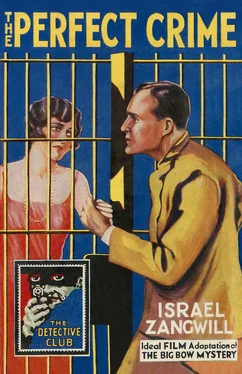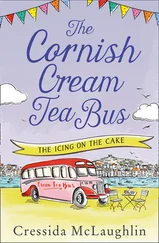Published by COLLINS CRIME CLUB
An imprint of HarperCollins Publishers Ltd
1 London Bridge Street
London SE1 9GF
www.harpercollins.co.uk
First published in Great Britain as The Big Bow Mystery by Henry & Co. 1892
Published as The Perfect Crime by The Detective Story Club Ltd
for Wm Collins Sons & Co. Ltd 1929
‘The Murders in the Rue Morgue’
first published by Graham’s Magazine 1841
Introductions © John Curran 2015
Cover design © HarperCollins Publishers Ltd 1929, 2015
A catalogue copy of this book is available from the British Library.
This novel is entirely a work of fiction. The names, characters and incidents portrayed in it are the work of the author’s imagination. Any resemblance to actual persons, living or dead, events or localities is entirely coincidental.
All rights reserved under International and Pan-American Copyright Conventions. By payment of the required fees, you have been granted the non-exclusive, non-transferable right to access and read the text of this e-book on screen. No part of this text may be reproduced, transmitted, down-loaded, decompiled, reverse engineered, or stored in or introduced into any information storage and retrieval system, in any form or by any means, whether electronic or mechanical, now known or hereinafter invented, without the express written permission of HarperCollins.
Source ISBN: 9780008137281
Ebook Edition © August 2015 ISBN: 9780008137298
Version: 2015-07-06
Contents
Cover
Title Page
Copyright Published by COLLINS CRIME CLUB An imprint of HarperCollins Publishers Ltd 1 London Bridge Street London SE1 9GF www.harpercollins.co.uk First published in Great Britain as The Big Bow Mystery by Henry & Co. 1892 Published as The Perfect Crime by The Detective Story Club Ltd for Wm Collins Sons & Co. Ltd 1929 ‘The Murders in the Rue Morgue’ first published by Graham’s Magazine 1841 Introductions © John Curran 2015 Cover design © HarperCollins Publishers Ltd 1929, 2015 A catalogue copy of this book is available from the British Library. This novel is entirely a work of fiction. The names, characters and incidents portrayed in it are the work of the author’s imagination. Any resemblance to actual persons, living or dead, events or localities is entirely coincidental. All rights reserved under International and Pan-American Copyright Conventions. By payment of the required fees, you have been granted the non-exclusive, non-transferable right to access and read the text of this e-book on screen. No part of this text may be reproduced, transmitted, down-loaded, decompiled, reverse engineered, or stored in or introduced into any information storage and retrieval system, in any form or by any means, whether electronic or mechanical, now known or hereinafter invented, without the express written permission of HarperCollins. Source ISBN: 9780008137281 Ebook Edition © August 2015 ISBN: 9780008137298 Version: 2015-07-06
Introduction
The Big Bow Mystery: BY ISRAEL ZANGWILL
Preface of Murders and Mysteries
Note
Chapter I
Chapter II
Chapter III
Chapter IV
Chapter V
Chapter VI
Chapter VII
Chapter VIII
Chapter IX
Chapter X
Chapter XI
Chapter XII
The Murders in the Rue Morgue: BY EDGAR ALLAN POE
Introduction
The Murders in the Rue Morgue
The Detective Story Club
About the Publisher
WHEN a corpse is found, with its throat cut and no sign of a weapon, in a room locked and bolted from the inside, both murder and suicide must be discarded as impossible. But writers of detective fiction, and their readers, are more circumspect. For them these fascinating conditions pose the questions: Whodunit? and, even more intriguingly, How?
Edgar Allan Poe’s ‘The Murders in the Rue Morgue’ (1841) was not only the first detective story, but also the first locked-room detective story; and The Big Bow Mystery (1892) by Israel Zangwill (1864–1926) was the first book-length example of the form. As such, it occupies an important place in the history of detective fiction.
The story first appeared in 1891 as a serial in the London daily Star newspaper, for which Zangwill worked at the time; it was published in book form the following year and collected in Zangwill’s The Grey Wig: Stories and Novelettes in 1903. In a preface, written for an 1895 edition of his book, the author perceptively acknowledged what is, in essence, the ‘fair-play’ rule of detective fiction (as adopted many years later by the Detection Club) when he wrote:
‘The indispensable condition of a good mystery is that it should be able and unable to be solved by the reader, and that that the writer’s solution should satisfy. And not only must the solution be adequate, but all its data must be given in the body of the story.’
Zangwill had long suspected, he explained, that ‘no mystery-monger had ever murdered a man in a room to which there was no possible access’ and that, although he had devised such a solution, it lay dormant until the editor of ‘a popular London evening newspaper’ asked him ‘to provide…a more original piece of fiction’. As the story unfolded—written in a fortnight ‘day by day’, according to the author—readers of the serial submitted ‘unsolicited testimonials in the shape of solutions’, although they ‘had failed, one and all, to hit on the real murderer’. (One can’t help wondering if the variety of possible solutions put forward in the course of the novel were some of these suggestions.)
The previous quarter-century had seen the publication of landmark novels of detective fiction: Wilkie Collins’s The Moonstone (1868), Charles Dickens’s The Mystery of Edwin Drood (1870), Anna Katharine Green’s The Leavenworth Case (1878). And in the years immediately preceding The Big Bow Mystery the appearance of the world’s first ‘consulting detective’, Sherlock Holmes, ushered in the pre-Golden Age of detective fiction. Two of Holmes’s full-length investigations— A Study in Scarlet (1888) and The Sign of (the) Four (1890)—were followed by the first dozen of the phenomenally successful short stories in the Strand magazine, beginning in July 1891 with ‘A Scandal in Bohemia’. So when Zangwill’s novel was published, the public appetite for crime fiction was well established—and almost insatiable.
Zangwill, the son of Latvian and Polish immigrants, was born in London’s East End and showed literary promise as early as eighteen. A teacher for some years after he graduated from London University, he eventually left the profession to write full-time, publishing hundreds of essays, as well as novels, short stories and plays produced in London and New York. His work concentrated on political, social and Jewish issues but The Big Bow Mystery was his only venture into detective fiction.
Given this background, his novel is more socially aware than many of its contemporaries. Two of the main characters are closely involved with the labour movement and a detailed picture of the social conditions of London’s East End and its denizens is conveyed through the characters and their circumstances. Dickensian names—the upright Arthur Constant, the hugely entertaining Mrs Drabdump, the enigmatic Edward Wimp, the elusive Jessie Dymond and the wonderfully named Denzil Cantercot—help to reinforce this milieu. A less than flattering picture of the police, and their initial attempts to solve the case, against a background of ‘a frigid grey mist’ and ‘cold [that] cut like a many-bladed knife’ contribute to the overall mood of a powerless stratum of society.
Читать дальше












